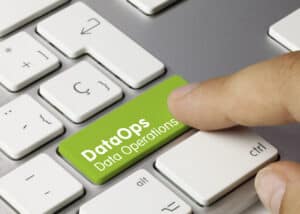
DataOps can help reduce time spent on busy work, allowing everyone from business leadership to entry-level data analysts to become more organized and data-driven.
Today’s hybrid enterprise environments pose a variety of challenges for database administrators. They’re being exposed to new and more complex tools that have the ability to make their job easier. However, change can be intimidating and hard-won if database administrators feel unprepared to accept those changes. Employees across the board already may not know how to fully utilize new technology or locate all the resources available to help them manage and access data. For database administrators, the crunch is even worse, as their organizations collect ever-increasing amounts of data, store databases in disparate locations, and demand it be put to use quickly for concrete business initiatives. Luckily, an emerging discipline – DataOps – can provide the foundation to unlock real-time database management that can help reduce the burden on database administrators, mitigate challenges in IT environments and improve business insights.
Database administrators can take significant advantage of DataOps to keep databases available, high-performing and agile. Here’s a roadmap for integrating DataOps into the fabric of real-time database management.
Do more database management with less
In hybrid enterprises, the data ecosystem has become so much more complex that it’s become a burden on its minders. For the database administrators grappling with increasing demands to support new database offerings, alongside legacy databases, the desire to innovate can be stymied by mundane tasks, as well as feelings of overwhelm and burnout.
In addition to feeling stressed, many employees tasked with working with data don’t always know what kind of data is available to them or how to use it. A Deloitte Analytics survey found that 66% of data within a business is often considered “low-quality” and is one of the main drivers towards holding data management progress back. It’s difficult to motivate database administrators to adopt new methods when they can’t even trust their own data; they need reassurance that they can solve that problem and that they’ll have the tools and support to get them there.
On top of managing data quality, database administrators are also in charge of maintaining high data performance in various cloud and on-prem environments, which impacts performance management, tuning, and optimization. It’s essential to gain full visibility into cloud infrastructure and activity, as well as the performance strength of data workloads throughout the organization – and this is a place where DataOps and automated tools can be helpful. By using performance tools and DataOps, database administrators will find it easier to automate, build and scale management systems. By doing this, they also make it easier to monitor database performance, fix service issues and ensure quality – whether it’s located in the cloud or on-prem.
If current processes or systems inadequately provide real-time insight, database administrators should feel empowered to make IT leaders and operations teams aware of the challenge and provide them with the specifics they need to improve time to insight. This is a process that database administrators must be key participants in if they want to make data operations run more smoothly.
One key way to do this is through training and upskilling in DataOps – which makes it easier to do more with less and apply those skills to real-time data management.
See also: A Good Data Analytics Program Relies on Good DataOps
Make upskilling for database administrators via DataOps a priority
Enterprise storage and data management have evolved rapidly over the last three years, and hybrid architectures are more popular than ever. Yet, for many businesses, training methods have remained the same, failing to adapt to new ways of working. New technologies are forcing database administrators to gain real-time skills utilizing different strategies for slightly different goals than they might have been before. To maintain strong data operations, IT leaders must invest in the training and upskilling of data scientists and database administrators regarding the latest practices.
Sometimes, the changes may seem small but are more impactful than expected. Different databases are often somewhat similar but not completely identical to each other. For example, database administrators might be asked to adopt, combine and manage entirely new types of database architectures. Rational open-source databases have many similarities to commercial relational databases, but differences still exist. Performance monitoring, workload analytics, query tuning, and instance resource optimization are unique to some extent among the different vendors’ offerings. With so many evolving types of data analytics and monitoring tools at their disposal, it’s easy to get overwhelmed; to counter that, database administrators need to be given a strong understanding of new database technologies and architectures so they can put themselves – and their organizations – in the best position to succeed.
It’s also crucial to provide training in additional cloud management and security skills in order to reduce the risk of data breaches or audit failures and ensure the effectiveness of cloud migrations and operations. Once database administrators understand how their day-to-day work intersects with cloud architecture and the business’s security needs, they’re able to improve operations while reducing risk.
By providing the right training and upskilling programs for their database administrators, IT leaders will make it easier for their teams to implement DataOps, automation, and other essential strategies for real-time management. Organizations will also see more effective cost control, higher levels of customer satisfaction, increased backup effectiveness and performance monitoring, and reduced burnout among their data teams.
Create a culture prioritizing DataOps and collaboration
That said, upskilling won’t be enough to guarantee improvement if IT leadership doesn’t create and encourage a culture of DataOps, agility, collaboration, and the empowerment of database administrators.
Database administrators can also help to build this culture by prioritizing and modeling collaboration, data accessibility, and visibility, which can make it easier to help democratize data use and ensure effective work across the organization.
Encouraging and setting standards for proactivity will also play a key part in this agile, collaborative culture, as data is being exposed to more risk than ever in today’s complex IT environments. IT leaders and database administrators alike must work together to set risk-reduction plans in place, ensure their vendors and partners are helping them with proactive problem-solving, and avoid performance issues. By ensuring that they have access to the culture and partnerships they need to scale DevOps, database administrators will be freed up to focus on essential, fulfilling tasks.
An optimal culture of DataOps empowers database administrators to collaborate on their toughest challenges, scale new solutions, optimize their organization’s data use, and prevent problems before they arise. With a strong internal plan for success and commitment to this culture, it becomes easier than ever to rally an organization around this hybrid data strategy and the benefits to all aspects of the business.
Conclusion
Database administrators are the people who make real-time database management possible – and building them up for success is no longer a nice-to-have but essential for successful business outcomes. By empowering them within their organizations to learn new skills, collaborate, and scale DataOps to reduce time spent on busy work, everyone from business leadership to entry-level data analysts will find themselves more organized, data-driven, and resilient against today’s business challenges.




























